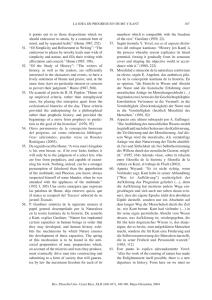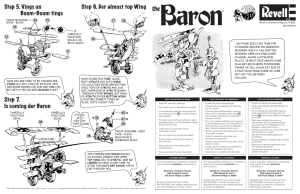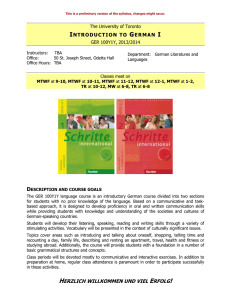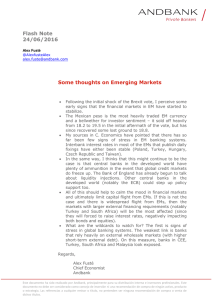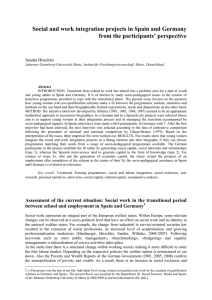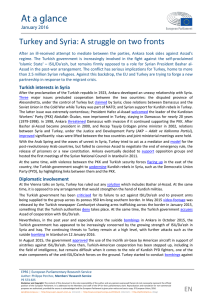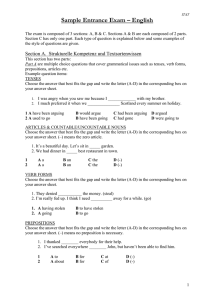Where is the Middle East? The Definition and Classification Problem
Anuncio
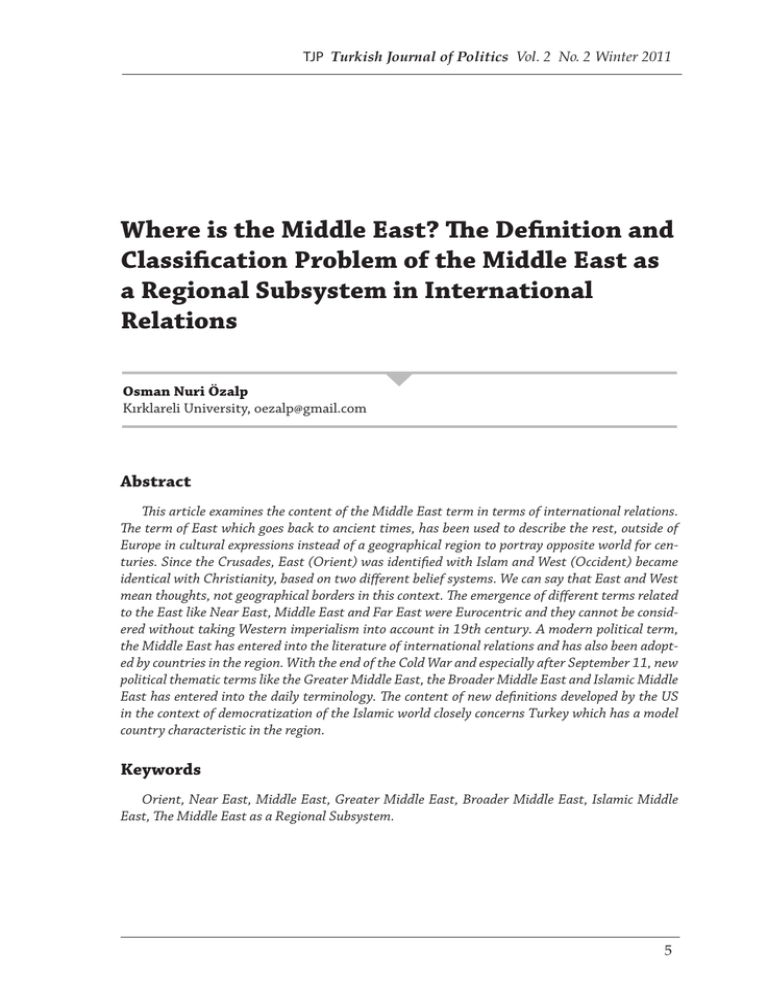
TJP Turkish Journal of Politics Vol. 2 No. 2 Winter 2011 Where is the Middle East? The Definition and Classification Problem of the Middle East as a Regional Subsystem in International Relations Osman Nuri Özalp Kırklareli University, oezalp@gmail.com Abstract This article examines the content of the Middle East term in terms of international relations. The term of East which goes back to ancient times, has been used to describe the rest, outside of Europe in cultural expressions instead of a geographical region to portray opposite world for centuries. Since the Crusades, East (Orient) was identified with Islam and West (Occident) became identical with Christianity, based on two different belief systems. We can say that East and West mean thoughts, not geographical borders in this context. The emergence of different terms related to the East like Near East, Middle East and Far East were Eurocentric and they cannot be considered without taking Western imperialism into account in 19th century. A modern political term, the Middle East has entered into the literature of international relations and has also been adopted by countries in the region. With the end of the Cold War and especially after September 11, new political thematic terms like the Greater Middle East, the Broader Middle East and Islamic Middle East has entered into the daily terminology. The content of new definitions developed by the US in the context of democratization of the Islamic world closely concerns Turkey which has a model country characteristic in the region. Keywords Orient, Near East, Middle East, Greater Middle East, Broader Middle East, Islamic Middle East, The Middle East as a Regional Subsystem. 5 TJP Turkish Journal of Politics Vol. 2 No. 2 Winter 2011 Introduction About forty five years ago, Pearcy had provocatively asserted that the Middle East is indeed an unidentified region (Pearcy 1964, 1-12). Actually, we see that very different kinds of ambiguous definitions about the region are used in the Western languages. Especially in recent years, terms like the Greater Middle East, the Broader Middle East and Islamic Middle East which are often used in the scientific literature and media make the response to the question, where borders of the region are exactly, more important than ever. If that is so, could not the region be properly defined? Where is the Middle East? Where its geographic boundaries start and end? In this article, the questions of where is the Middle East and what is the Middle East will be discussed in the context of international relations. However, the geographic definition of the Middle East is impossible when we considered the fact that the term has been used as an opposition to the West intellectually since ancient Greece. Over time, the term historically, culturally, religiously, geographically, politically and economically became more complex. In order to better understand the region, the concept of sub-regional system in the international relations developed by Bassam Tibi for the Middle East will be used. However, we need to look briefly at how the terminology was formed from prehistoric times to the present for better understanding of relevant approaches to the Middle East. Where is the East? We see the perceptions and the definitions related to the East in the ancient works for the first time where these had direct ef- 6 fect on the mental designs of the modern times.1 The East was initially comprised of Egypt in ancient Greece at the geographical sense. The fall of New Assyrian Kingdom (B.C. 911–610), then establishment of the Greater Persian Empire (the Achaemenid Dynasty, B.C. 550–330) and Persian dominance in Anatolia have left profound scars on the Greek literature and thought. The wars between the Persians and the Ancient Greeks in this period make up the source of mind imaginations related to two different geographies that has effect to the present days. Specifics of the Persians are characterized by despotism in “the Persians” 2 (B.C. 524–456) a drama theatre of the ancient Greek writer Aeschylus3 (Bichler, 2007: 478). In this way, the Asia as a geographical area has become the symbol of tyranny and barbarism. Although in the book of Aeschylus, Asia is not shown as anti-polar of Europe, but this point of view has influenced subsequent writers. Aeschylus is also the first writer mentioning about the Arabs in the ancient World in his studies (Schlicht 2008, 12). Later on, we see the influence of Aeschylus in the book of the Histories of Herodotus from Halicarnassus who is considered to be the father of historians. (B.C. 490-425). “The history starts with a preface on a legendary beginning of animosity between Europeans and Asians” (Irwin, 2008: 18). So much so 1 For further information look at Reinhold Bichler, “Der ‘Orient’ im Wechselspiel von Imagination und Erfahrung: Zum Typus der ‘orientalischen Despotie’, Getrennte Wege? Kommunikation, Raum und Wahrnehmungen in der Alten Welt, Ed. Robert Rottinger, Andreas Luther, Josef Wiesehöfer, Verlag Antike, Frankfurt, 2007 p. 475. 2 The work named Persians of Aeschylus carries the feature of the oldest drama from the ancient world to the present. It was firstly played in Athens at B.C 472. 3 Latin Aischylos or Aeschylus TJP Turkish Journal of Politics Vol. 2 No. 2 Winter 2011 that Herodotus makes separation between Hellenes and Barbarians at the very beginning of his second sentence (Herodotos 2009, 5). He explicitly mentions on Europe and Asia where the Greeks’ country is identified between Europe and Asia.4 While Herodotus congratulates the conqueror Greeks against the Persians, he positions Hellenes, Europeans against the Barbarians. This viewpoint then became a symbol of opposition between two different civilizations: Europe and Asia. When we look at the works of authors like Aeschylus, Euripides and Herodotus in the ancient world, we can say that anti-orient cliché (stereotyping) was laid the foundations in the Greek literature. In medieval Europe, the Romans used the term of Oriens that takes its roots from a Latin word “sol oriens” that means sunrise for defining the area. Then, they implied Eastern half that is the Byzantine (3951453) of the Roman Empire (Pflitsch 2003, 11) (Jedlitschka, 2004: 22). Once again in this period, the term was also used for the east of Jerusalem which was named as the Holy Land with its broadest sense in the context of the tradition of the Holy Bible. In the middle ages, at the end of 11th century with the start of Crusades worldview of the Europe that was almost unchanged since the ancient times began to widen (Jankrift, 2007, 12). Inter-cultural knowledge and property transfer developed through the Crusades. For the first time, Europeans again began to regain rich heritage the ancient world thanks to this encounter. Arabic works of Aristotle were translated into Latin which began to reshape Western thought. Islam became one of the most important characteristic of the East with In ancient world, the Greeks were naming the northern area of Peloponnese which we name Balkans today as Europe. Centuries later, the term widened and started to be used for whole the continent. 4 the Crusades in the Medieval Europe. Thus, there was laid the foundations of a relationship between the Christian West (Occident) and the Islamic East (Orient) in context of two different belief systems. The term of Orient was generally used in Europe for identifying a wide range region including Arabic-speaking countries, Turkey, Iran, India and even China till nineteenth century. Over time, many different definitions have been used in Western languages at regional description.5 Krause who takes into consideration of different definitions in different languages and in different times is stating that actually clear and systematic classification of definitions related to the Middle East is not possible (Krause, 1993: 4). However if there is something common to these different definitions, it is also the point of view of European perspective. Because, when it is only looked from Europe then the East becomes Near, Middle or Far. More precisely, it is necessary to look at the history of imperialism in order to understand the term of the Middle East in the modern sense (Tibi 1989, 55). Race to capture and share the Middle East was begun between the European great powers after Napoleon’s Egyptian Campaign (1798-1801). In terms of regional geopolitics, the region was seen as a whole by the Europe. Such that, the partial problems of the region cannot independently be addressed since that time because it has been integrated into the world politics as a whole (Jedlitschka 2004, 22). The situation still remains valid. 5 For instance in German Morgenland, Levante, Fruchtbarer Halbmond, Vorderasien, Vorderer Orient, Naher Osten, Mittlerer Osten; in French Proche Orient, Moyen Orient; in English Far East, Near East, Middle East. 7 TJP Turkish Journal of Politics Vol. 2 No. 2 Winter 2011 By that time, either East or Orient used for whole Asia. The first distinction between Asia and Europe has emerged in nineteenth century, no longer than the Europeans have used the term of the Far East for China, Japan, Malaysia and Indonesia. This distinction has prevailed until the end of nineteenth century. Now, the East for the Europe was starting at the borders of the Ottoman Empire. While the Ottoman Empire as ‘’sick man of the Bosporus” was at the brink of collapse period, in the 19th century, sharing the territory of the Empire turned into a conflict due to the different national interests of the European powers. Who would take of which area of the Ottoman Empire that was in the decline period. This conflict that can be very shortly summarized was called the Eastern Question in the Europe (Brown 1984, 87138). Almost all political definitions relevant to the Middle East and foundation of a large portion of the political boundary changes is based on the sovereignty and beginning of establishment of spheres of influence by the British, French, Russians and Germans in this region at the end of 19th century and first half century of the 20th century (Ehlers 1990, 10). In this context, a change in terminology took place in 1890 where the term of the Near East has been used for the first time. The Near East term was rather used to describe the Southeastern Europe including the Balkan region. The region was East because of being still a part of the Ottoman Empire whereas it was near because being the Christian European, however it was also still the East because of remaining under the sovereignty of an Eastern state of the Ottoman Empire (Lewis 1968, 10). 8 The Emergence of Modern Middle East as a Political Term As stated above, we see the usage of the terms of Near East and Far East to define whole the East in the terminology until the end of 19th century. However, in September 1902 A. Th. Mahan, an American naval historian, has published an article called ‘’The Persian Gulf and International Relations’’ in the British National Review magazine where for the first time he used the phrase of the Middle East for the Gulf of Aden and India (Davison 1963, 17). According to the concept of Mahan, the Middle East was the region between the Suez and Singapore. Two months later after Mahan’s article, Valentin Chirol a reporter of the British Times newspaper began to publish a series of articles titled “the Middle East Question” (Davison 1963, 17). Thus, term of the Middle East centered by India was settled in the international literature after the publication of Mahan and Chirol. To sum up briefly in light of the above developments, we see settlement of three different terms to describe the East until the end of First World War that are the Near East, the Middle East and the Far East. Each term was used to define a particular region and as meaning the Near East was including Turkey, the Middle East was including India and the Far East was including China (Davison 1963, 17). The Ottoman Empire allied with Germany against France and British in order to prevent the collapse in the World War I. This led the escalation of competition between European states who were working to gain influence over the Ottoman Empire. France and Britain started to support the Arabs against the Ottoman Empire. At the same time they signed secretly the Sykes-Picot TJP Turkish Journal of Politics Vol. 2 No. 2 Winter 2011 Treaty (1916) on how to share the Arab lands that were still under the Ottoman Rule (Klaff 1993, 50). According to the secret plan, and later by the San Remo Conference (1920), Syria and Lebanon were left to the French; Palestine, Iraq and Trans-Jordan were left to the British administration. 6 There was need on the change of the definitions and contents related to the Middle East in the light of these historical developments. Indeed, according to the British point of view, Winston Churchill was determining the context of the Middle East term as of a region from Bosporus to the western borders of India in March 1, 1921 with the contributions of the Royal Geographical Society. Until then, India was now outside of the new definition where it was remaining in the Middle East term before. In this way, the Middle East term started to cover the geographical area where the Near East was meant before (Davison 1963, 19). The Middle East Term During the Cold War The structure of the region has begun to change in parallel with the structural changes of great powers as globally after the Second World War. The British were weakened at the end of the war which has made the boundaries of the region even more uncertain. Pax Americana was now substituted in the region instead of Pax Britannica where the Middle East region became more strategic for its energy resources before the America (Tibi 1989,56). The Middle East term in during the Second World War has become more popular 6 During Sykes-Picot process competition between British-French and Arab Policy see: Brown, International Politics and, p. 117. with the Middle East Command covering the area especially of the British domain from Malta to Iran and Syria, from there to Ethiopia (Davison 1963, 20). The term was settled in a robust manner in the international relations literature, especially after the war, while the Near East term has begun to lose importance and content in the face of intensive use of the Middle East term. The Middle East term has become a single phrase in the political language for defining the region in the English-speaking countries. The term with its English meaning firmly settled in everyday language where even the countries of the region have adopted it.7 Delimitation Problem of the Middle East Despite the settlement of the Middle East term in the international literature, there is not common agreement on the extension of the geographical areas and the Middle East countries (Johannsen 2006, 11). So where does the Middle East exactly place? Boundaries of the Middle East are determined with very different forms because of different interests, criteria and scientific disciplines. In a broad meaning, we can state that the Middle East covers a region from Ethiopia in the south, Turkey in the north, Afghanistan and Pakistan in the east to Morocco in the west. There are very different criteria and approaches to determine the boundaries of the Middle East in this wide geographic area. We will try to show how complex the topic in the scientific literature by providing particular titles of different views in this study. 7 Turkish: Ortadoğu, Arabic: al-sharq al-awsat, Persian: Khavarmiyaneh, Hebrew: ha Mizrach ha Tichon 9 TJP Turkish Journal of Politics Vol. 2 No. 2 Winter 2011 When we look at the writers who take into account the geographic criteria related to determination of the boundaries of the Middle East we again see different approaches. For example, the Middle East is the region between the Black Sea, Mediterranean, Red Sea, Arabian Gulf and the Caspian Sea according to Tunçdilek (Tunçdilek 1971, 3). Swiss geographer Boesch uses the term of Mittlerer Osten in German for the Middle East and himself sees the boundaries of the region as the geographic area between the Levant coast and its hinterland, the plains of the Tigris and Euphrates rivers, the North Arabian Desert areas and the Arabian Gulf (Ehlers 1990,12). The area between Morocco and Afghanistan, the Middle East as an American Hurewitz is defined. Brown is one of the experts who live today against this important region of the former Ottoman Empire in the Middle East sees as its fields. , Because today’s Algeria, Tunisia, Libya, Lebanon, Egypt, Syria, Palestine, Iraq and the Arabian Peninsula belonging to the Middle East and of course the Republic of Turkey were altogether under the rule of the Ottoman Empire in 19th century according to Brown. This is content to describe the Middle East region, Iran, Morocco and covers areas other than those belonging to the Ottoman geography can say. At the work of Politisches Lexikon Nahost issued by Steinbach/Hofmayer/Schönborn the region is defined as the area between Morocco in the west and Pakistan in the east. (Steinbach, 1979) Then, at the same way, the region is confirmed as the area between Maghreb region in the West and Pakistan in the east at the two volume study Handbuch des Nahen und Mittleren Ostens issued by Steinbach/Robert (Steinbach, 1988, 16). According to Steinbach, he uses both the terms of Naher und Mittlerer Os- 10 ten while he divides the region in two main sections as North Africa Wing and Southeast Asia Wing (Steinbach, 1988, 16). The area of the Middle East is defined between Morocco and Afghanistan by an American Hurewitz (Hurewitz 1969, 3). On the other hand, Brown who is one of the experts living today sees the Middle East as the fields where the former Ottoman Empire has possessed (Brown 1984, 7-11). Because, today’s Algeria, Tunisia, Libya, Lebanon, Egypt, Syria, Palestine, Iraq and the Arabian Peninsula of the Middle East and of course the Republic of Turkey were under the rule of the Ottoman Empire since nineteenth century according to Brown. We can say that the Middle East region covers areas other than those belonging to the Ottoman geography except Iran and Morocco according to the definition in this context. Hudson sees the Middle East as a whole consisting of three partial systems: the Arab East (Mashreq), the North Africa (Maghreb) and the Gulf Region (Khaleej) (Hudson 1976, 483). Tibi, who is considered to be the region’s foremost experts, divides the Middle East to three sub-regions like Hudson, but he holds the countries of this sub-system as the centric and edge countries (Tibi 1989,73). TJP Turkish Journal of Politics Vol. 2 No. 2 Winter 2011 The Middle East and its Parts as Sub-System According to Tibi The Arab East (Mashreq) The Gulf Region (Khaleej) The Arab West (Maghreb) Centric Countries Edge Coutries Centric Countries Edge Coutries Centric Countries Edge Coutries Egypt Turkey Iraq Bahrein Algeria Tunisia Mauritania Israel Cyprus Iran Qatar Morocco Syria Sudan S. Arabia U.A.E. Libya Jordan N. Yemen Kuwait Umman Lebanon S. Yemen Source: Tibi, Konfliktregion Naher Osten, p. 76. According to Tibi, inclusion of a state to the region depends on whether the interested state is integrated into the sub-system. In general, approaches of defining the area and limiting criteria at the scientific literature in the period until the end of the Cold War had been like explained above. However, major changes in international relations after the collapse of the Soviet Union and after independence of the Central Asian countries have radically changed the terminology related to the Middle East. Collapse of the Soviet Union and its Effect on the Middle East Terminology With the collapse of the Soviet Union, a major process of change took place in international relations and all geographic areas of the world such as the Middle East were also deeply affected.8 So much so, that all the definitions and limitations of the Middle East 8 Effect of end of Cold War to the Middle East see: Heinz-Dieter Winter, “Vom Kriesenbogen zur stabilen Friedensordnung?”, WeltTrends, No 16, 1997, pp. 95–112; Helmut Hubel, Das Ende Kalten Krieges im Orient. Die USA die Sowjetunion und die Konflikte in Afghanistan, am Golf und im Nahen Osten (1979– 1991), Oldenbourg, München, pp. 246–255. have been changed. We will deal with the descriptive approaches relevant to the Middle East in the context of new developments in the international relations. After the collapse of the Soviet Union the countries of Azerbaijan, Kazakhstan, Turkmenistan, Kyrgyzstan, Uzbekistan and Tajikistan which had Muslim majority population and had the Islamic cultural tradition in the Central Asia and the Caucasus gained their independence. According to some authors, these countries that are still in the process of multi-faceted transformation have caused the formation of a new large region in cultural and political meaning due to their Islamic identities. For example, according to Lewis, these countries which are part of the Middle East in cultural, ethnic, linguistic and religious meaning in the past have again provided the formation of this historic dimension after their independence: “This formation of new Middle East is truly one of the most important developments for the old Middle East.” according to him (Lewis 1992, 103). Trautner one of the authors sharing this point of view no more proposes the term of the Islamic Orient (islamischer Orient) for the region (Trautner 1997, 9). Because, Islamic culture is dominant in the geography 11 TJP Turkish Journal of Politics Vol. 2 No. 2 Winter 2011 that starts from Western-Sahara countries to Tajikistan albeit in different forms. In this context, Lindholm has also chosen the term of the Islamic Middle East (Lindholm, 2004, 29). Pfetsch who is a conflict expert in international relations uses the term of the Arab-Islamic World (arabisch-islamische Welt) which has almost same meaning with taking into account the cultural familiarity to the region (Pfetsch 1991,7). Büttner/Scholz have stated that the borders of the Middle East expanded to include the Central Asia as a result of the new political developments formed after the collapse of the Soviet Union; have used the term of the Islamic- Oriental -World or the Islamic- Oriental-Region for the geographical region from Mauritania to the Central Asia (Büttner and Schulz, 1993, 16). In addition, Büttner/Schulz have expressed that identifications stemmed from historical, political or media requirements for the region today in fact make the both inner and outer decomposition difficult and they advocated the identification of the Middle East as the a sub-system (Büttner and Scholz, 1993, 42). Because the geographical region from Mauritania to Afghanistan has a common conflict structure in terms of international relations. Gantzel/Schwinghammer have expressed the expansion of the region including the Caucasus and the Central Asia after the disintegration of the Soviet Union and saw Georgia in the Middle East unlike other writers (Gantzel and Schwinghammer, 1995, 39). Meanwhile, Schmid separates the whole region into four sub-regions by taking into account of the different geographical conflict areas due to the politi- 12 cal changes in 1990s (Schmid 1993, 26). the Central Asia, Mashreq, the Gulf Region and Maghreb. Pawelka stresses that the boundaries of the region had a dynamic structure and the Islamic character in the historical process and states that its borders extens from the Atlantic coast of Africa to the Altai Mountains in the Central Asia after collapse of the Soviet Union (Pawelka and Wehling 1999, 7). The Developments Related to the Term of the Middle East After September 11, 2001 September 11, 2001 terrorist attacks profoundly affected the international system, such as they almost radically changed the terms and scope of the debate related to the Middle East.9 Immediately after the terrorist attacks the terms like the Greater Middle East, the Broader Middle East or the Islamic Greater Middle East entered into the literature of the international relations. On the identification and the scope in 19th and 20th century and today at the beginning of 21st century the terminology on the Middle East is determined by the great powers (Ehrhardt and Johannsen, 2005, 11). Today, the boundaries of the Middle East, the countries of the Middle East are solely determined by the only global superpower USA. At the same time, America has the power to set such political terminology. American political scientist Harkavy wrote, for the first time, an arti9 For new geopolitical situation of the Middle East after September 11 look at: Sigrid Faath (Hrsg.), Neue geopolitische Konstellationen im Nahen Osten nach dem 11. September 2001, DÜI, Hamburg, 2003. TJP Turkish Journal of Politics Vol. 2 No. 2 Winter 2011 cle about the concept of “the Greater Middle East” in the light of geopolitical developments (Harkavy, 2001,37-53). (Harkavy and Kemp 1997) Later on, strategists like Ronald D. Asmus and Kenneth M. Pollack who took office in Bill Clinton Administration have developed the idea of democratic transformation of the Great Middle East. Indeed they published their views as a new transatlantic project at the fall of 2002 (Pollack and Assmus, 2003). To summarize, America should take initiative for the political transformation of the Great Middle East for a long period according to Asmus and Pollack. The Neo-cons who were influential in George W. Bush Administration advocated a new and radical fresh start on the democratization of the Middle East. In this context, President Bush began to express his project named “the Greater Middle East Initiative” (GMEI) at every opportunity towards the end of 2003. The project was intended to establish democracies in the entire Islamic world (Schoch, 2005: 30-48). Model concept of the project was embodied at the G-8 Summit held in Sea Island, Georgia; then its content was published for the first time in Al-Hayat English Newspaper based in London.10 The geography which was described as the Greater Middle East in the Project comprised the Arab League countries, Israel, Iran, Turkey, Afghanistan and Pakistan. The Central Asian countries was not included in the project, because these countries were already acting with the United States in her joint fight against terrorism within the scope of policy and the US began to deploy military bases in their territories after the September 11. 10 The concept was published at al Hayat Newspaper on 13.02.2005 as Working Paper “G8 Greater Middle East Partnership”. After publication of the Greater Middle East Project, both the Arab world and the European Union sharply criticized it. In particular, the EU announced its first concept under the title of “The Strategic Partnership of the European Union with the Mediterranean and the Middle East” on March 22, 2004 as an alternative to the Greater Middle East Project.11 In this context, the concept of the Greater Middle East Initiative (GMEI) was accepted with its new shape, the Broader Middle East Initiative (BMEI) after intensive discussions and interviews at the G-8 Summit held in the Sea Island on June 9, 2004.12 The difference of the concept of the Broader Middle East from the Greater Middle East is the expansion to encompass the Gulf countries and the North African countries. In general, the West targets the start and the support of political and economic reform processes in the majority of the Islamic Countries; to create a common structure based on long-term stability, prosperity and democracy by means of these projects. Of course what is missing in these projects, selected by the West as a vision, is the lack of strategy on how to achieve this goal.13 On 11 For the concept of the EU see: Muriel Asseburg, “Demokratieförderung in der arabischen Welt – hat der partnerschaftliche Ansatz der Europäer versagt?”, Orient, No 2, 2005, pp. 272–290. 12 US Department of State: Partneship for Progress and a Commen Future with the Region of the Broader Middle East and North Africa. Fact Sheet, The White Hause Office of the Press Secretary, June 9, 2004. 13 On the transformation process towards the Middle East, approach differences between USA and Europe see: Elmar Janssen, Stabilität in Nahost? Transformationsansätze von USA und EU und strukturelle Hindernisse einer Friedensordnung, m-ress, München, 2005; Martin Beck, “Von der Spannung über die Krise zur Gemeinsamkeit? Zu den auβenpolitischen Ansätzen und Perspektiven der USA und der EU gegenüber dem Nahen Osten”, Ehrhart/Johannsen, Herausforderung Mittelost: Übernimmt sich 13 TJP Turkish Journal of Politics Vol. 2 No. 2 Winter 2011 the subject of democratization of the Islamic World which could be a subject of separate study, there is sharp disagreement between the U.S. and the EU in terms of method. This also reduces the chance of success of all the projects for the region. While the term of the Broader Middle East has been accepted in Istanbul on 28, 29 June 2004 at NATO Summit, the term of the Greater Middle East has more commonly been used at the scientific literature and public opinion. Today in our country, Turkey, even the definition of the Greater Middle East is adopted as a term in every day usage. For this reason, therefore the term of the Greater Middle East will be preferred as a definition. However, the issue of what countries are covered by the Greater Middle East, again, is not clear as we saw in previous definitions. Though, from new term it is easily understood that the boundaries of the region have more extended content. But the subjects of what countries enter into this term, however, differ according to the intention of those who use the term. In short, America has politically re-defined and expanded the boundaries of the region with the Greater Middle East Project after September 11. Can Turkey and the Central Asia be Included in the Middle East Regional Sub-system? The theories of regional sub-systems in the international relations have entered into the literature as of the end of 50s. American political scientist and Middle East expert Leonard Binder wrote an article “The der Westen?, ss. 164–180.; Isabel Shäfer, “Die “Strategische Partnerschaft der EU mit dem Mittelmeerraum und dem Nahen Osten” – eine europäische Alternative zur “Broader Middle East Initiative?”, Ehrhart/Johannsen, Herausforderung Mittelost: Übernimmt sich der Westen? pp. 128–148. 14 Middle East as a Subordinate International System” (Binder, 1958: 408-429). in 1958 where, for the first time, he expressed that there are regional differences in the international system and regional subsystems constitute a totality within themselves. After this study of Binder many political scientists have developed different concepts of regional sub-systems in the international relations. However, there is also not a common view among them. Binder’s concept was developed by Middle East expert Bassam Tibi a Syrian-German born political scientist at the end of 80’s (Tibi, 1989). According to Tibi, on the one hand regional sub-systems keep their own dynamics, on the other hand they are also structurally integrated with the international system through the reciprocal interaction. In short, it can be classified under the global system. According to Tibi, a connection (linkage) with the local, regional and international conflict areas was formed in the region until around 1989/90s (Tibi 1989, 46). As we mentioned earlier, Tibi sees the Middle East as a sub-region of the international system and classifies this sub-region into three partial areas consisting of central and edge countries which are the Mashreq, the Maghreb and the Gulf Region. However, the international system has been radically altered after the concept developed by Tibi in 1989. After the collapse of the Soviet Union bipolar order was disappeared and the Cold War was ended. After these changes that opened a new era in the international system, how we can answer the following questions in the context of Tibi’s concept? • Can regional sub-systems still be placed in the international system? • Can Turkey be included in the Middle TJP Turkish Journal of Politics Vol. 2 No. 2 Winter 2011 East regional sub-system? • Can the Central Asian countries that gained independence after disintegration of the Soviet Union be evaluated in this system? In our opinion the Middle East continuous to be the regional sub-system even having a higher degree of autonomy after 1989. According to Krause after the fall of the Soviet Union the developments consolidated the Middle East in the political and historical sense so that the region which was once defined under the name of the Orient as a cultural geography has turned into the same structure again (Krause 1993, 9). For this reason, borders of the region have begun to be broadly defined due to its Islamic character. Indeed, most characteristic feature of the geographic region that extends from the West Sahara up to Tajikistan is to have social structure of Islamic culture despite economic and political differences (Trautner 1997, 9). Today, the Middle East region still holds important position in the world politics. However, non-regional Powers - the United States and the EU - want to transform political systems to establish a peaceful order in the long term for the Middle East region that is among the world’s most full of conflict regions. In this context, the Greater Middle East project of the Americans that is mentioned in the previous section, aims at the reconstruction of a democratic political structures in the region. However, as Americans want to realize it in radical methods, Europeans rather advocates stable and gradual manner to support this process.14 Differ14 Democracy Promotion of USA and Europe in the Middle East and its details see: Sabine Giesendorf, Politische Konditionalität der EU – eine erfolgreiche Demokratieförderungsstrategie? Nomos, Baden Baden, 2009, pp. 43–77. ent policies held by the United States and the EU which adopt different methods for the political transformation, in fact, undermines the stability of the region. That’s way, a transatlantic co-operation for the successful transformation of the region is important not only for the Middle East but also for the international relations. Inclusion of Turkey into the System As discussed above, Tibi has classified Turkey as edge country under the name of the Arab East (Mashreq) in his study in 1989. However, many writers indicate that Turkey became centric country especially after the Gulf War and subsequent developments (Trautner 1992, 33; Robins 1992, 85). When the recent political developments are considered, Turkey can be put in the Middle East as a regional sub-system in the international relations. The following factors can be listed for Turkey to become a centric country in the Middle East and an active regional player: • To play an active role in the Second Gulf War • The Kurdish issue gained an international dimension • Importance of water shortage, Turkey has the river sources of Tigris and Euphrates • America’s support to Turkey as a model country for the Muslim states in the framework of the Greater Middle East Project Turkey has been praised as a model for the Central Asian countries after the collapse of the Soviet Union and then for this purpose Turkey had made extensive economic, political, cultural and diplomatic ini- 15 TJP Turkish Journal of Politics Vol. 2 No. 2 Winter 2011 tiatives. In 90s, especially America supported Turkey both geo-strategically to avoid the influence of Iran in the Central Asia as well as to be a model country in the Central Asia. Turkey’s regional importance grew even further especially after September 11. This time, Americans began to support Turkey which has an Islamic socio-cultural structure and also successfully operates a democratic political system together as a model country in the whole Islamic world with the Greater Middle East Project. Turkey was the best model country for the entire Islamic world especially for the effective Neocons in Bush Administration. America continues to support Turkey as a democratic model in the Islamic world in the framework of the Greater Middle East Project after September 11 until now as it was in 90s for the Central Asia. In this context, Turkey’s EU membership process was supported particularly by the American authorities.15 Because Turkey would have become a guide and model country in the Middle East with the rise of democratic standards thanks to the European Union. The role and the pressure of the United States played for Turkey to gain the status of EU candidate should be seen as a decision having strategic importance in the context of long-term transformation of the Middle East (Janssen 2005, 136). America’s policy towards Turkey can also be seen as a part of regionally and globally oriented policy. Turkey also plays an important role for the EU in the region in this context. Even though the U.S and the EU have differences of opinion on some issues towards the Middle East; a successful Turkey which is carrying out de15 Support of EU membership of Turkey from American perspective see Carsten Hanke, “Die Beitrittsperspektive der Türkei zur Europäischen Union aus der Sicht der USA”, Kölner Arbeitspapiere zur internationalen Politik, No 43, 2006. 16 mocracy and Islam together has paramount importance for the West. Turkey with her modern Muslim cultural identity, democratic and economically successes, having the EU standards will play an important role as a model country in the Middle East, the Caucasus and the Central Asia; it can also be an effective model of the policies that encourage stability in the concerned regions. Turkey with these characteristics is an pivotal country in the Middle East for the America and the EU in the international relations. AKP government in Turkey has become an important regional player in the Middle East due to the features stated above. Turkey can be included in the Middle East regional sub-system because of all these developments of late years. Inclusion of the Central Asia Newly independent Central Asian countries after the collapse of the Soviet Union have also brought a new term debates on the agenda in the context of the Middle East. The Central Asia and Caucasus were part of the Orient on cultural, ethnic, linguistic and religious aspects of historical sense in the past (Fragner and Kappeler 2006; Strasser 2002). For example, the Central Asia was a centric region of the Islamic Civilization not the edge one in the Middle Ages. So much so that al-Farabi, al-Bukhari, al-Biruni, Avicenna, al-Maturidi, Ali Qushji and such many important personalities of the Islamic world were emerged in the Central Asia. With the independence and separation of the Central Asian Republics from the Soviet Union, the Islamic world has again attained its old historical geographical spread in cultural meaning. After independence, the relations of the Central Asian countries TJP Turkish Journal of Politics Vol. 2 No. 2 Winter 2011 with the other Islamic countries began in all areas. Considering these developments, the issue of whether the Middle East regional sub-system includes the Caucasus and the Central Asia according to the concept of Tibi can be discussed (Krause 1993, 3). According to the concept Tibi, the regional sub-systems are not only geographic areas, but are also the systems where there are structural relations and mutual interaction processes in specific forms. This mutual interaction processes can take place within the framework of factors pertaining to the linguistic, ethnic, socio-economic and cultural. Considering the above factors in relation to the subject, we can say that there is the vast majority of the population belonging to the religion of Islam and a rising Islamic identity in the Central Asia. The ethnic relation with Turkey, the countries of the region (except Tajikistan) and relationship with the other Islamic countries for having religious belonging show the effect of the Middle East on the region. Indeed, all the Central Asian countries have become members of the Organization of the Islamic Conference in the 90s. Three countries have launched the competition namely Saudi Arabia to spread Wahhabi version of Islam, Iran with Shiite version of Islam and Turkey with Sunni version of Islam especially in the Caucasus and the Central Asia after the downfall of the Soviet Union. In this regard, Kuwait, United Arab Emirates and Pakistan have made efforts in the Islamic activities. Once again, there has been influx of students from the Central Asian countries to the universities in the Islamic world. For instance, Turkey itself gave the opportunity of scholarships to more than 10,000 Central Asian students. Studying in different Islamic countries also pro- vided opportunity to these students to meet and interact with the different Islamic movements. Robins argues that the borders of the Middle East can be expanded including the Central Asia because of four criteria: the state system, culture, religion and language (Robins 1994, 55-74). Robins also states that both the regions have common historical, cultural and political heritage. State system in the Middle East was formed after the collapse of the Ottoman Empire in 19th century. There is no historical root of today’s state borders in the region because the colonial powers have formed the state structures or administrative districts in parallel with full of their own interests. We see the presence of same process of state establishment in the Central Asia. The Caucasus and the Central Asia regions were under the domination of Tsarist Russia in 19th century. After the 1917 October Revolution, Moscow began to establish new administrative units in Central Asia in 1920s. The new administrative boundaries were decided as contrary to any of the historical, ethnic, cultural and social structure of the region. According to this administrative regulations Uzbekistan, Turkmenistan (1924), Tajikistan (1929), Kazakhstan and Kyrgyzstan (1936) were built as the Soviet Republics. None of the states formed under the borders nor names were present before the October revolution. Islamic culture is effective on the social structure in the Central Asia as it is in the Middle East. Long-term stable political order would only be possible with the integration of the Islamic forces into the political system. In general, we can say that Islam increases its effect in the political life in the region day by day. Moreover, the leaders of the region benefit from the Islamic culture 17 TJP Turkish Journal of Politics Vol. 2 No. 2 Winter 2011 and symbols in the nation-building process. In the framework of briefly explained issues above we can assert that the Central Asia and the Middle East have these following similar structural characteristics: lack of legitimacy of the state administrators, weakness of the state, family, state and social structure forms, the relationship system depending on the person (the clan, tribe, race, ethnic/religious/regional communities, client and patronage relationships), the problem of Islam’s integration into the political system, strong regional, ethnic and religious identities and informal structures. The Central Asian countries moved to the center of the international agenda with the America’s entry into Afghanistan after September 11. Countries of the region have extended their support to the United States and NATO in the fight against terrorism. At the same time September 11 events also attracted the attention of the existence of states in the form of weakness and collapse in the international relations. Seizure of Afghanistan by the militant Islamists exemplifies how the countries in form of poor state could be captured by the trans-national terrorist network. In this context, threats to the regional stability occur not externally, but rather occur from the erosions at the internal structures of the Central Asia countries. Many problems like religious, ethnic and regional identities which, awaits the solution, indicate that the region will be in long term tension. Due to the reasons briefly mentioned above, we can include the Central Asian countries into the Middle East regional subsystem. Conclusion When the term of Orient is examined in historical perspective, it is seen that this 18 term has been used for all Eastern cultures. The East is entirely an abstract idea of the West rather than being geographical. This form of perception has influenced the political, religious and thought structure of the Europe for centuries. In political terminology, the origin of different terms related to East is based on the European imperialism at the end of 19th century or at the beginning of 20th century. In this context, we see that the competition of sharing the territory of the Ottoman Empire in her collapse is called as the Eastern Question in the field of international relations. Spread of the Middle East term in the political literature took place after the Second World War. However, there is no consensus on which geographical areas and countries are covered by the region. We see Tibi’s concept of regional sub-system more descriptive on defining the Middle East. According to the concept, on one hand the region has its own systemic characteristics on the other hand it has integrated into the global world politics. The degree that the countries belong to the regional sub-system are determined by political criteria, not historical characteristics. These are; the structural linkages and density of interaction. No doubt that the international system has undergone very big change after Tibi’s concept in 1989. We see that the process of regionalization and regional political structures have gained weight in the international system with the removal of bipolar structure in the world. Global conflicts have left their place to regional conflicts. In this context, the concept that Tibi developed for the Middle East still keeps its descriptive feature. When we look at the process from end of the Cold War to the present, we can say that Turkey has become a centric coun- TJP Turkish Journal of Politics Vol. 2 No. 2 Winter 2011 try and integrated into the Middle East regional sub-system. The term of the Greater Middle East introduced at the terminology in recent years can be considered as appropriate definition when near period and current process of the region are taken into consideration. The Author has, here, brought a new classification to the Greater Middle East as regional subsystem according to their conflict zones: The Greater Middle East 1. Arab West (Maghreb), Egypt, Sudan, Southern Sudan 2. Arab East (Mashreq), Turkey, the Islamic Caucasus 3. Horn of Africa: Ethiopia, Somalia, Djibouti, Eritrea 4. The Gulf region 5. The Central Asia 6. South Asia: Afpak16 (Afghanistan and Pakistan) As a result, reasons for the lack of consensus on the very different definition and on the issue of boundaries at the scientific literature related to the Middle East can be summarized as following: • Most of the definitions related to the Middle East are the European-based and they are defined with different content and different times in the United Kingdom, France and Germany. • Most of the European-based definitions are shaped according to the interests of the imperialist point of view and of the great powers. • Term of the Middle East is not primarily a geographical definition, rather it is a modern political term. It has, again, dynamic characteristics according to the changes in the world politics and changes in the region (the Greater Middle East, the Broader Middle East and etc.) The debate about the definition becomes important in terms of both a better understanding of current political developments in the geography of region including Turkey and prediction of regional political perspectives of the major powers towards near future. At this point, it should be noted that term of the Middle East contains not a geographical restriction, but the political and cultural identity. In parallel with the changes in world politics and regional developments, it is always likely to make new definitions related to the Middle East. • Different official agencies of different countries define different definitions and border for the Middle East. • Different branches of science use different definitions for the Middle East. • Definition of the Middle East can be done in various ways because of different interests. 16 Afpak term is for the first time used by Richard Holbrook special representative of US President Barack Obama to Afghanistan and Pakistan. 19 TJP Turkish Journal of Politics Vol. 2 No. 2 Winter 2011 References Asseburg, Muriel. 2005. Demokratieförderung in der arabischen Welt – hat der partnerschaftliche Ansatz der Europäer versagt? Orient, 2005/2, pp. 272-290. Beck, Martin. 2005. Von der Spannung über die Krise zur Gemeinsamkeit? Zu den außenpolitischen Ansätzen und Perspektiven der USA und der EU gegenüber dem Nahen Osten. Ehrhardt, Hans-Georg/Johannsen, Margret (Hrsg.), Herausforderung Mittelost: Übernimmt sich der Westen?. Baden-Baden: Nomos. Harkavy, Robert and Geoffrey Kemp. 1997. Strategic Geography and the Changing Middle East: Concepts, Definitions, and Parameters. Washington: Brookings Press. Harkavy, Robert. 2001. Strategic Geography and the Greater Middle East. Naval War College Review, No 4. Herodotos. 2009. Tarih. Translated by Müntekim Ökmen. İstanbul: Türkiye İş Bankası Kültür Yayınları. Hubel, Helmut. Das Ende Kalten Krieges im Orient. Die USA, die Sowjetunion und die Konflikte in Afghanistan, am Golf und im Nahen Osten (1979–1991). München: Oldenbourg. Bichler, Reinhold. 2007. Der “Orient” im Wechselspiel von Imagination und Erfahrung: Zum Typus der “orietalischen Despotie”, Rottinger, Robert; Luther, Andreas; Wiesehöfer, Josef: Getrennte Wege? Kommunikation, Raum und Wahrnehmungen in der Alten Welt, Verlag Antike: Frankfurt. Hudson, Michael D., 1976. “The Middle East.”. In World Politics, edited by James Rosenau, pp. 476-500, New York: Free Press. Binder, Leonard. 1958. “The Middle East as a Subordinate International System.” In: World Politics 10/1958, pp. 408-429. Irwin, Robert. 2008. Oryantalistler ve Düşmanları. Translated by Bahar Tırnakcı. İstanbul: YKY. Brown, Carl L., 1984. International Politics and the Middle East. Old Rules, Dangerous Game. London: I. B. Tauris. Büttner, Friedemann and Fred Scholz. 1993. “Islamisch-orientalische Welt: Kulturtradition und Unterentwicklung”. Handbuch der Dritten Welt. Band Nordafrika und Naher Osten. Dieter Nohlen, (Hrsg), Bonn: Dietz. pp. 16-66. Davison, Roderic H. 1963. “Where is The Middle East?” In The Modern Middle East, edited by Richard H. Nolte, pp. 13-30, New York: Atherton. Ehlers, Eckart. 1990. Der Islamische Orient Grundlagen zur Länderkunde eines Kulturraums. Köln: Isl. Wiss. Akad. Ehrhardt, Hans-Georg and Margret Johannsen. 2005. Herausforderung Mittelost: Übernimmt sich der Westen?. Baden-Baden: Nomos Faath, Sigrid (Hrsg.). 2003. Neue geopolitische Konstellationen im Nahen Osten nach dem 11. September 2001. Hamburg: DÜI. Fragner, Bert and Andreas Kappeler (Hrsg.). 2006. Zentralasien. 13. bis 20. Jahrhundert. Geschichte und Gesellschaft. Wien: Promedia. Gantzel, Klaus J. and Thorsten Schwinghammer. Die Kriege nach dem Zweiten Weltkrieg 1945–1992, Daten und Tendenzen. Münster: Lit. Giesendorf, Sabine. 2009. Politische Konditionalität der EU – eine erfolgreiche Demokratieförderungsstrategie? Baden Baden: Nomos. Hanke, Carsten. 2006. Die Beitrittsperspektive der Türkei zur Europäischen Union aus der Sicht der USA. Kölner Arbeitspapiere zur internationalen Politik, No 43. 20 Hurewitz, Jacob. 1969. Middle East Politics. New York: Praeger. Jankrift, Kay Peter. 2007. Europa und der Orient im Mittelalter. Darmstadt: WBG. Janssen, Elmar. 2005. Stabilität in Nahost? Transformationsansätze von USA und EU und strukturelle Hindernisse einer Friedensordnung. München: M-ress. Jedlitschka, Anja. 2004. Weibliche Emanzipation in Orient und Okzident. Von der Unmöglichkeit, die Andere zu befreien. Würzburg: Ergon Verlag. Johannsen, Margret. 2006. Der Nahost-Konflikt. Wiesbaden: VS. Klaff, Rene. 1993. Konfliktstrukturen und Außenpolitik im Nahen Osten. Das Beispiel Syrien. Berlin: Dunker und Humblot. Krause, R. Dietrich. 1993. “Orient, Naher und Mittlerer Osten. Die Begriffe im Wandel der Zeit”, Geographische Rundschau1. 4-9. Lewis, Bernard. 1968. The Middle East and the West, London: Weidenfeld and Nicolson. Lewis, Bernard. 1992. “Rethinking the Middle East.” Foreign Affairs 4: 99-119. Lindholm, Charles. 2004. İslami Ortadoğu Tarihsel Antropoloji. Translated by Balkı Şafak. İstanbul: İmge. Pawelka, Peter and Hans-Georg Wehling (Hrsg.). 1999. Der Vordere Orient an der Schwellezum 21. Jahrhundert. Politik, Wirtschaft, Gesellschaft, Opladen: Westdt. Pearcy, G. E. 1964. The Middle East - an Indefinable Region Washington. Department of State Publication 7684, Near and Middle East Series 72. Pfetsch, Frank R. (Hrsg.). 1991. Konflikte seit 1945: Daten-Fakten-Hintergründe, Bd. 5: Arabisch-islamische Welt. Freiburg/Breisgau: Ploetz. Pflitsch, Andreas. 2003. Mythos Orient Eine Entdeckungsreise, Freiburg/Basel: Herder. TJP Turkish Journal of Politics Vol. 2 No. 2 Winter 2011 Pollack, Kenneth P. and Ronald D. Asmus. 2002. “The New Transatlantic Project”, Policy Review, October/November. Robins, Philip. 1992. “Turkish Policy and the Gulf Crisis. Adventure or Dynamics?”, In Turkish Foreign Policy, New Prospects. edited by Clement H. Dodd, 7087. Huntingdon: The Eothen Press. Robins, Philipp. 1994. “The Middle East and Central Asia.” In The New Central Asia and its Neighbours, edited by Peter Ferdinand, 55-74, Royal Institute of International Affairs. London: Pinter. Shäfer, Isabel. 2005. “Die “Strategische Partnerschaft der EU mit dem Mittelmeerraum und dem Nahen Osten” – eine europäische Alternative zur “Broader Middle East Initiative”?”, In Herausforderung Mittelost: Übernimmt sich der Westen?, Hans-Georg Ehrhardt, Margret Johannsen, 128-148. Baden-Baden: Nomos Schoch, Bruno. 2005. “Washington’s “Greater Middle East Initiative” - eine ernst zu nehmende Vision”, In Herausforderung Mittelost: Übernimmt sich der Westen?, Hans-Georg Ehrhardt, Margret Johannsen, 30-48. Baden-Baden: Nomos Schlicht, Alfred. 2008. Die Araber und Europa. 2000 Jahre gemeinsamer Geschichte, Stuttgart: Kohlhammer. Schmid, Claudia. 1993. Der Israel-Palästina Konflikt und die Bedeutung des Vorderen Orient als sicherheitspolitische Region nach dem Ost-West-Konflikt, Baden-Baden: Nomos. Steinbach, Udo (Hrsg). 1979. Politisches Lexikon Nahost, München: Beck. Steinbach, Udo (Hrsg.). 1988. Der Nahe und Mittlere Osten. Politik, Gesellschaft, Wirtschaft, Geschichte, Kultur, 2 Bd. Opladen: Leske&Büdrich Strasser, Andrea (Hrsg.). 2002. Zentralasien und Islam, Hamburg: Dt. Orient-Inst. Tibi, Bassam. 1989. Konfliktregion Naher Osten. Regionale Eigendynamik und Groβmachtinteressen, München: Beck. Trautner, Bernhard. 1992. Eigendynamik, regionale Einbindung und Internationalisierung zwischenstaatlicher Konflikte im Nahen und Mittleren Osten: Erster und Zweiter Golfkrieg, Heidelberg Univ.: Magisterarbeit. Trautner, Bernhard. 1997. Konstruktive Konfliktbearbeitung im Vorderen und Mittleren Orient: Ansätze der Deeskalation und Beilegung nationaler und internationaler Konflikte 1945-1995, Münster: Lit Tunçdilek, Necdet. 1971. Güneybatı Asya. İstanbul: İst. Ünv. Yay. Winter, Heinz-Dieter. 1997. “Vom Kriesenbogen zur Stabilen Friedensordnung?”, WeltTrends, No 16: 95-112. 21
